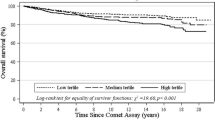Abstract
We studied the levels of extracellular nuclear and mitochondrial DNA of blood serum and DNA damage in leukocytes of healthy donors of different sex and age groups. The baseline levels of DNA damage in leukocytes and serum DNA levels were shown to vary greatly among different donors. The baseline level of DNA damage in leukocytes was not associated with the presence of chronic deceases or an occupational health risk for elderly donors. It was found that extracellular DNA concentrations were generally higher in men than in women. There is a tendency towards an increase in the relative mitochondrial DNA copy number determined by ΔCt in women but not in men: the relative mtDNA copy number in elderly individuals varies significantly in both sexes, possibly due to age-related physiological changes. It is necessary to consider the gender and age of patients when using an indicator such as the level of extracellular DNA of blood serum for diagnosis and monitoring.

Similar content being viewed by others
REFERENCES
C. Kohler, Z. Barekati, R. Radpour, and X. Y. Zhong, Anticancer Res. 31, 2623 (2011)
Y. I. Elshimali, H. Khaddour, M. Sarkissyan, et al., Int. J. Mol. Sci. 14 (9), 18925 (2013). https://doi.org/10.3390/ijms140918925
D. Chandrananda, N. P. Thorne, M. Bahlo, BMC Med. Genomics. 8, 29 (2015). https://doi.org/10.1186/s12920-015-0107-z
R. R. Zachariah, S. Schmid, N. Buerki, et al., Obstet. Gynecol. 112 (4), 843 (2008). https://doi.org/10.1097/AOG.0b013e3181867bc0
S. N. Tamkovich, V. V. Vlassov, and P. P. Laktionov, Mo. Biol. (Moscow) 42 (1), 9 (2008). https://doi.org/10.1134/S0026893308010020
M. Yu, Mitochondrial DNA 23 (5), 329 (2012). https://doi.org/10.3109/19401736.2012.696625
S. Rapisuwon, E. E. Vietsch, and A. Wellstein, Comput. Struct. Biotechnol. J. 14, 211 (2016). https://doi.org/10.1016/j.csbj.2016.05.004
K.-A. Yoon, S. Park, S. H. Lee, et al., J. Mol. Diagn. 11 (3), 182 (2009). https://doi.org/10.2353/jmoldx.2009.080098
W. Chen, F. Cai, B. Zhang, and X. Y. Zhong, Clin. Chem. Lab. Med. 50 (2), 261 (2011). https://doi.org/10.1515/cclm.2011.773
A. Szpechcinski, J. Chorostowska-Wynimko, and R. Struniawski, et al., Br. J. Cancer 113 (3), 476 (2015). https://doi.org/10.1038/bjc.2015.225
G. Sozzi, D. Conte, L. Mariani, et al., Cancer Res. 61 (12), 4675 (2001).
S. N. Tamkovich, O. E. Bryzgunova, E. Yu. Rykova, et al., Clin. Chem. 51 (7), 1317 (2005). https://doi.org/10.1373/clinchem.2004.045062
X. Y. Zhong, S. Hahn, V. Kiefer, and W. Holzgreve, Ann. Hematol. 86 (2), 139 (2007). https://doi.org/10.1007/s00277-006-0182-5
D. Czeiger, G. Shaked, H. Eini, et al., Amer. Soc Clin. Pathol. 135 (2), 264 (2011). https://doi.org/10.1309/AJCP4RK2IHVKTTZV
J. Jylhava, T. Kotipelto, A. Raitala, et al., Mech Ageing Dev. 132 (1–2), 20 (2011). https://doi.org/10.1016/j.mad.2010.11.001
N. P. Sirota and E. A. Kuznetsova, Bull. Exp. Biol. Med. 145 (2), 194 (2008).
E. I. Azzam, J. P. Jay-Gerin, and D. Pain, Cancer Lett. 327, 48 (2012) https://doi.org/10.1016/j.canlet.2011.12.012
M. P. A. Hannon-Fletcher, M. J. O’Kane, K. W. Mo-les, et al., Mutat. Res. 460 (1), 53 (2000). https://doi.org/10.1016/s0921-8777(00)00013-6
M. Harangi, E. Remenyik, I. Seres, et al., Mutat. Res. 513 (1–2), 17 (2002). https://doi.org/10.1016/s1383-5718(01)00285-6
P. Sanchez, R. Penarroja, F. Gallegos, et al., Arch. Med. Res. 35 (6), 480 (2004). https://doi.org/10.1016/j.arcmed. 2004.11.008
J. Blasiak, M. Arabski, and R. Krupa, Mutat. Res. 554 (1–2), 297 (2004). https://doi.org/10.1016/j.mrfmmm. 2004.05.011
R. Demirbag, R. Yilmaz, A. Kocyigit, Mutat. Res. 570 (2), 197 (2005). https://doi.org/10.1016/j.mrfmmm.2004.11.003
A. J. Sigurdson, M. Hauptmann, B. H. Alexander, et al., Mutat. Res. 586 (2), 173 (2005). https://doi.org/10.1016/j.mrgentox.2005.07.001
A. Collins, M. Milic, S. Bonassi, and M. Dusinska, Mutat. Res. 843, 1 (2019). https://doi.org/10.1016/j.mrgentox. 2019.06.002
W. Copeland and M. J. Longley, DNA Repair (Amst.) 19, 190 (2014). https://doi.org/10.1016/j.dnarep.2014.03.010
P. Moller, L. Knudsen, S. Loft, and H. Wallin, Cancer Epidemiol. Biomarkers Prev. 9 (10), 1005 (2000).
N. K. Chemeris, A. B. Gapeyev, N. P. Sirota, et al., Mutat. Res. 558, 27 (2004). https://doi.org/10.1007/1-4020-4278-7_7
D. P. Lovell and T. Omori, Mutagenesis 23 (3), 171 (2008). https://doi.org/10.1093/mutage/gen015
J. Knez, E. Winckelmans, and M. Plusquin, Am. J. Epidemiol. 183 (2), 138 (2016). https://doi.org/10.1093/aje/kwv175
C.-Y. Xia, Y. Liu, H.-R. Yang, et al., Chin. Med. J. 130 (20), 2435 (2017). https://doi.org/10.4103/0366-6999.216395
Funding
The studies were carried out within the framework of the basic part of state assignment of the Ministry of Education and Science of the Russian Federation, R&D no. 1878 “The Development of Fundamental Aspects of Molecular Diagnostics and Mitochondrial Pharmacology.”
Author information
Authors and Affiliations
Corresponding author
Ethics declarations
Conflict of interests. The authors declare that they have no conflict of interest.
Statement of compliance with standards of research involving humans as subjects. All procedures performed in studies involving human participants were in accordance with the ethical standards of the institutional and/or national research committee and with the 1964 Helsinki Declaration and its later amendments or comparable ethical standards. Informed consent was obtained from all individual participants involved in the study.
Additional information
Translated by E. Makeeva
Abbreviations: %TDNA, DNA percentage in a comet tail; cfDNA, cell-free DNA; nDNA, nuclear DNA; mtDNA, mitochondrial DNA; qPCR, real-time (quantitative) polymerase chain reaction.
Rights and permissions
About this article
Cite this article
Mitroshina, I.Y., Sirota, N.P., Prokofiev, V.N. et al. Levels of Circulating DNA in Blood Serum and DNA Damage in Leukocytes of Healthy Donors of Different Genders and Ages. BIOPHYSICS 66, 310–315 (2021). https://doi.org/10.1134/S0006350921020147
Received:
Revised:
Accepted:
Published:
Issue Date:
DOI: https://doi.org/10.1134/S0006350921020147




